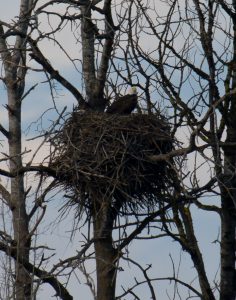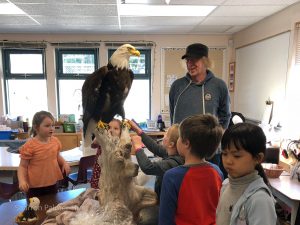Gabriola Eagle Nest Monitoring Program
A number of Gabriolans are participating in an eagle nest-monitoring program with the BC Federation of Naturalists. Their Wildlife Tree Stewardship (WITS) initiative has created a network of property owners and environmentally minded citizens committed to mapping and monitoring eagle nest activities on Vancouver and the Gulf Islands. Their purpose is to work together to protect essential nesting habitat so we can keep the Georgia Basin’s population of Bald Eagles a vibrant and healthy part of our coastal communities.
Most Bald Eagle nests and perch trees are found within 100-200 metres of the coast. Eagles build massive nests, usually in 200-400 year old Douglas Fir. There are very few stands of the original coastal forest remaining and single “veteran” nest trees, spared by logging and development, are gradually being lost to natural decay or are being removed because of their danger of falling on homes.
Here on Gabriola we have 23 recorded nests with ongoing reports of possible new nests. April is a good time to note nest activity and update the status of active nests. Winters can be stormy, sometimes resulting in nest casualties. Property development can change nesting habitat quickly. Gabriola is fortunate to have a number of dedicated community members who have monitored and help protect nests in their neighborhoods. New property owners are often unaware of the natural history of their property. In the past we have lost a nest to an indiscriminate developer and there has been an increase in complaints about building and clearing near nests. It is important for Gabriolans to take a proactive role in protecting, recording, and informing other community members about, our local eagle habitat.
Destroying a Bald Eagle’s nest at any time of the year, whether it is occupied or not, is a criminal offense (maximum fine $100,000.00).
AVOID tree or branch clearing, excavation or any other disturbance nest trees during the nesting season (January –August).
DESIGNATE the Bald Eagle nest tree a “Wildlife Tree” by contacting the Ministry of Environment.
RETAIN mature trees and some younger replacement trees on private property to ensure there are suitable nest trees for the future.
PARTICIPATE in local eagle nest monitoring and community education by joining WITS
For more information please contact your local coordinators:
Darlene Mace 250-247-7415
Iain Lawrence 250-247-7656
Website:. www.wildlifetree.org
By Darlene Mace
